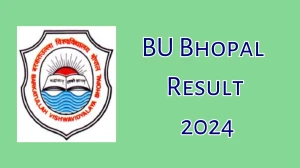- Rojgarlive »
- Education »
- UK Board Class 12 Chemistry Syllabus 2024-25 @ ubse.uk.gov.in Check Syllabus, Exam Pattern Details Here
UK Board Class 12 Chemistry Syllabus 2024-25 @ ubse.uk.gov.in Check Syllabus, Exam Pattern Details Here
by Keerthika
Updated Jun 04, 2024

UK Board Class 12 Chemistry Syllabus 2024-25 @ ubse.uk.gov.in
The Uttarakhand Board of School Education (UBSE) has officially unveiled the much-awaited syllabus for class 12 students for the academic session 2024-25. The syllabus for all subjects is now available on Jagran Josh's school section. Specifically focusing on aiding students, we have provided the syllabus for UK Board Class 12 Chemistry. This comprehensive syllabus includes details regarding course content, units, marking scheme, and practical examination.
Check - UK Board Class 12 Chemistry Syllabus 2024-25
UK Board Class 12 Chemistry Course Structure
|
Title |
Marks |
|
Solutions |
07 |
|
Electrochemistry |
09 |
|
Chemical Kinetics |
07 |
|
d -and f -Block Elements |
07 |
|
Coordination Compounds |
07 |
|
Haloalkanes and Haloarenes |
06 |
|
Alcohols, Phenols and Ethers |
06 |
|
Aldehydes, Ketones and Carboxylic Acids |
08 |
|
Amines |
06 |
|
Biomolecules |
07 |
UK Board Class 12 Chemistry Syllabus 2024-25
|
Unit I: Solutions Types of solutions, expression of concentration of solutions of solids in liquids, solubility of gases in liquids, solid solutions, Raoult's law, colligative properties - relative lowering of vapour pressure, elevation of boiling point, depression of freezing point, osmotic pressure, determination of molecular masses using colligative properties, abnormal molecular mass, Van't Hoff factor. |
|
Unit II: Electrochemistry Redox reactions, EMF of a cell, standard electrode potential, Nernst equation and its application to chemical cells, Relation between Gibbs energy change and EMF of a cell, conductance in electrolytic solutions, specific and molar conductivity, variations of conductivity with concentration, Kohlrausch's Law, electrolysis and law of electrolysis (elementary idea), dry cell-electrolytic cells and Galvanic cells, lead accumulator, fuel cells, corrosion. |
|
Unit III: Chemical Kinetics Rate of a reaction (Average and instantaneous), factors affecting rate of reaction: concentration, temperature, catalyst; order and molecularity of a reaction, rate law and specific rate constant, integrated rate equations and half-life (only for zero and first order reactions), concept of collision theory (elementary idea, no mathematical treatment), activation energy, Arrhenius equation. |
|
Unit IV: d and f Block Elements General introduction, electronic configuration, occurrence and characteristics of transition metals, general trends in properties of the first row transition metals – metallic character, ionization enthalpy, oxidation states, ionic radii, colour, catalytic property, magnetic properties, interstitial compounds, alloy formation, preparation and properties of K2Cr2O7 and KMnO4. Lanthanoids - Electronic configuration, oxidation states, chemical reactivity and lanthanoid contraction and its consequences. Actinoids - Electronic configuration, oxidation states and comparison with lanthanoids. |
|
Unit V: Coordination Compounds Coordination compounds - Introduction, ligands, coordination number, colour, magnetic properties and shapes, IUPAC nomenclature of mononuclear coordination compounds. Bonding, Werner's theory, VBT, and CFT; structure and stereoisomerism, importance of coordination compounds (in qualitative analysis, extraction of metals and biological system). |
|
Unit VI: Haloalkanes and Haloarenes Haloalkanes: Nomenclature, nature of C–X bond, physical and chemical properties, optical rotation mechanism of substitution reactions. Haloarenes: Nature of C–X bond, substitution reactions (Directive influence of halogen in monosubstituted compounds only). Uses and environmental effects of - dichloromethane, trichloromethane, tetrachloromethane, iodoform, freons, DDT. |
|
Unit VII: Alcohols, Phenols and Ethers Alcohols: Nomenclature, methods of preparation, physical and chemical properties (of primary alcohols only), identification of primary, secondary and tertiary alcohols, mechanism of dehydration, uses with special reference to methanol and ethanol. Phenols: Nomenclature, methods of preparation, physical and chemical properties, acidic nature of phenol, electrophillic substitution reactions, uses of phenols. Ethers: Nomenclature, methods of preparation, physical and chemical properties, uses. |
|
Unit VIII: Aldehydes, Ketones and Carboxylic Acids Aldehydes and Ketones: Nomenclature, nature of carbonyl group, methods of preparation, physical and chemical properties, mechanism of nucleophilic addition, reactivity of alpha hydrogen in aldehydes, uses. Carboxylic Acids: Nomenclature, acidic nature, methods of preparation, physical and chemical properties; uses. |
|
Unit IX: Amines Amines: Nomenclature, classification, structure, methods of preparation, physical and chemical properties, uses, identification of primary, secondary and tertiary amines. Diazonium salts: Preparation, chemical reactions and importance in synthetic organic chemistry. |
|
Unit X: Biomolecules Carbohydrates - Classification (aldoses and ketoses), monosaccahrides (glucose and fructose), D-L configuration oligosaccharides (sucrose, lactose, maltose), polysaccharides (starch, cellulose, glycogen); Importance of carbohydrates. Proteins -Elementary idea of - amino acids, peptide bond, polypeptides, proteins, structure of proteins - primary, secondary, tertiary structure and quaternary structures (qualitative idea only), denaturation of proteins; enzymes. Hormones - Elementary idea excluding structure. Vitamins - Classification and functions. Nucleic Acids: DNA and RNA. |
UK Board Class 12 Chemistry Syllabus 2024-25? -FAQ
- Visit the official website of the UK board - ubse.uk.gov.in/ or uaresults.nic.in.
- Click on Board Results.
- Enter roll number and captcha code in the class 10 login window.
- Click on 'Get Result'
- The result will be displayed on the screen.
To check the results of the UP Board 10th and 12th you will have to go to the official website upmsp.nic.in. There you will have to click HSC (Class 10th) Examination Results or HSSC (Class 12th) Examination Results




